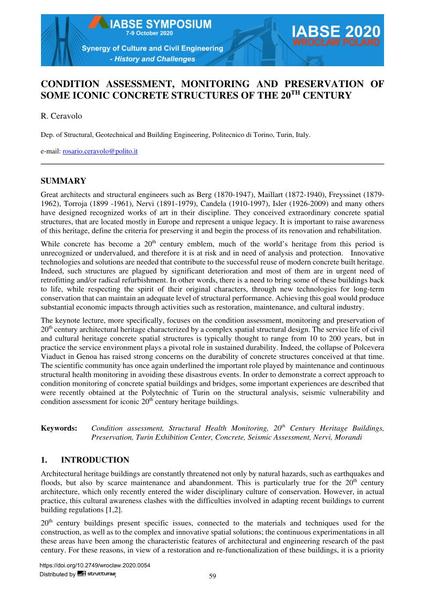Condition Assessment, Monitoring and Preservation of Some Iconic Concrete Structures of the 20th Century

|
|
|||||||||||
Bibliografische Angaben
| Autor(en): |
R. Ceravolo
(Dep. of Structural, Geotechnical and Building Engineering, Politecnico di Torino, Turin, Italy)
|
||||
|---|---|---|---|---|---|
| Medium: | Tagungsbeitrag | ||||
| Sprache(n): | Englisch | ||||
| Tagung: | IABSE Symposium: Synergy of Culture and Civil Engineering – History and Challenges, Wrocław, Poland, 7-9 October 2020 | ||||
| Veröffentlicht in: | IABSE Symposium Wroclaw 2020 | ||||
|
|||||
| Seite(n): | 59-82 | ||||
| Anzahl der Seiten (im PDF): | 24 | ||||
| Jahr: | 2020 | ||||
| DOI: | 10.2749/wroclaw.2020.0054 | ||||
| Abstrakt: |
Great architects and structural engineers such as Berg (1870-1947), Maillart (1872-1940), Freyssinet (1879- 1962), Torroja (1899 -1961), Nervi (1891-1979), Candela (1910-1997), Isler (1926-2009) and many others have designed recognized works of art in their discipline. They conceived extraordinary concrete spatial structures, that are located mostly in Europe and represent a unique legacy. It is important to raise awareness of this heritage, define the criteria for preserving it and begin the process of its renovation and rehabilitation. While concrete has become a 20th century emblem, much of the world’s heritage from this period is unrecognized or undervalued, and therefore it is at risk and in need of analysis and protection. Innovative technologies and solutions are needed that contribute to the successful reuse of modern concrete built heritage. Indeed, such structures are plagued by significant deterioration and most of them are in urgent need of retrofitting and/or radical refurbishment. In other words, there is a need to bring some of these buildings back to life, while respecting the spirit of their original characters, through new technologies for long-term conservation that can maintain an adequate level of structural performance. Achieving this goal would produce substantial economic impacts through activities such as restoration, maintenance, and cultural industry. The keynote lecture, more specifically, focuses on the condition assessment, monitoring and preservation of 20th century architectural heritage characterized by a complex spatial structural design. The service life of civil and cultural heritage concrete spatial structures is typically thought to range from 10 to 200 years, but in practice the service environment plays a pivotal role in sustained durability. Indeed, the collapse of Polcevera Viaduct in Genoa has raised strong concerns on the durability of concrete structures conceived at that time. The scientific community has once again underlined the important role played by maintenance and continuous structural health monitoring in avoiding these disastrous events. In order to demonstrate a correct approach to condition monitoring of concrete spatial buildings and bridges, some important experiences are described that were recently obtained at the Polytechnic of Turin on the structural analysis, seismic vulnerability and condition assessment for iconic 20th century heritage buildings. |
||||
| Stichwörter: |
Beton Bestandsbewertung Erhaltung Baudenkmale des 20. Jahrhunderts
|
||||
